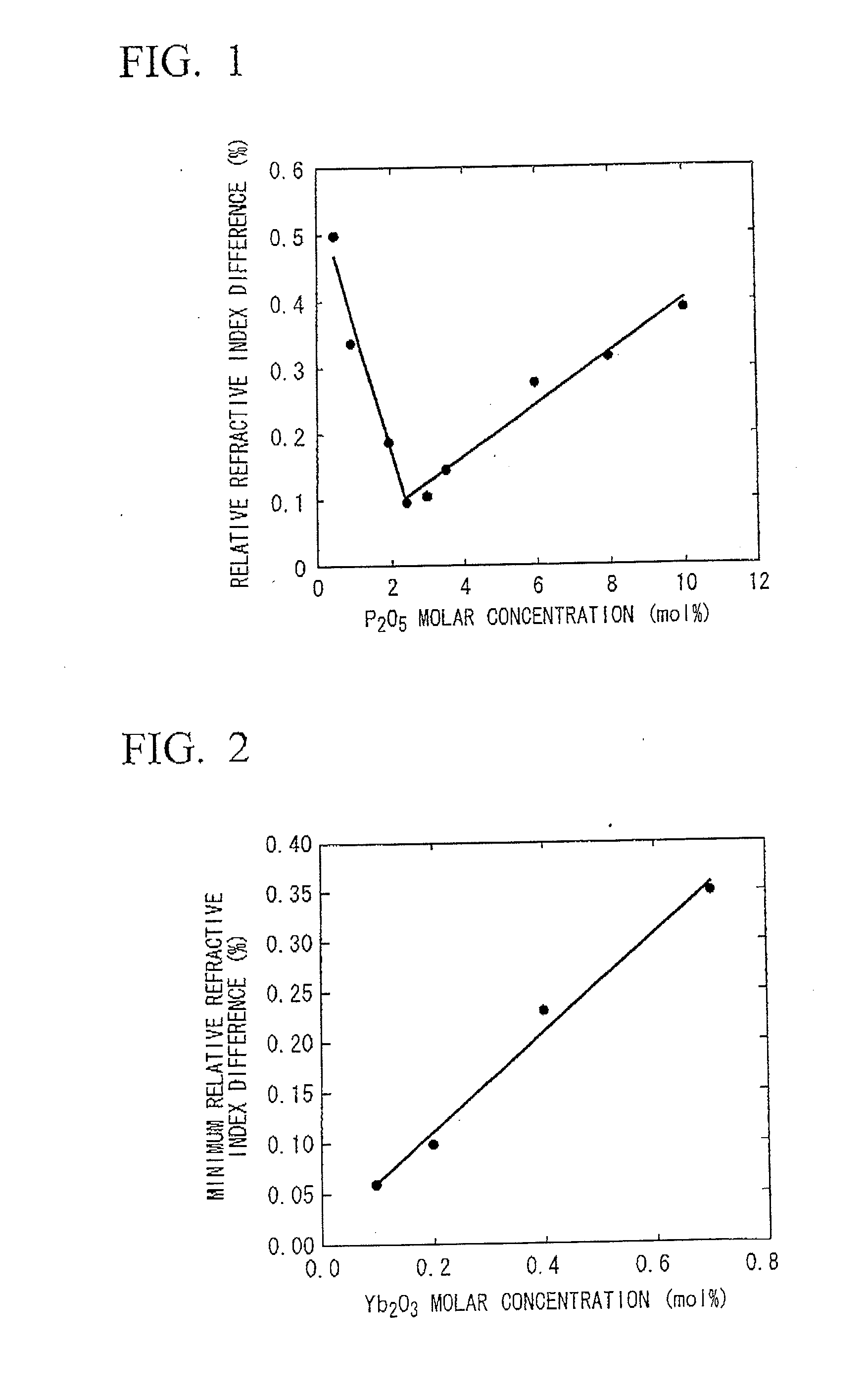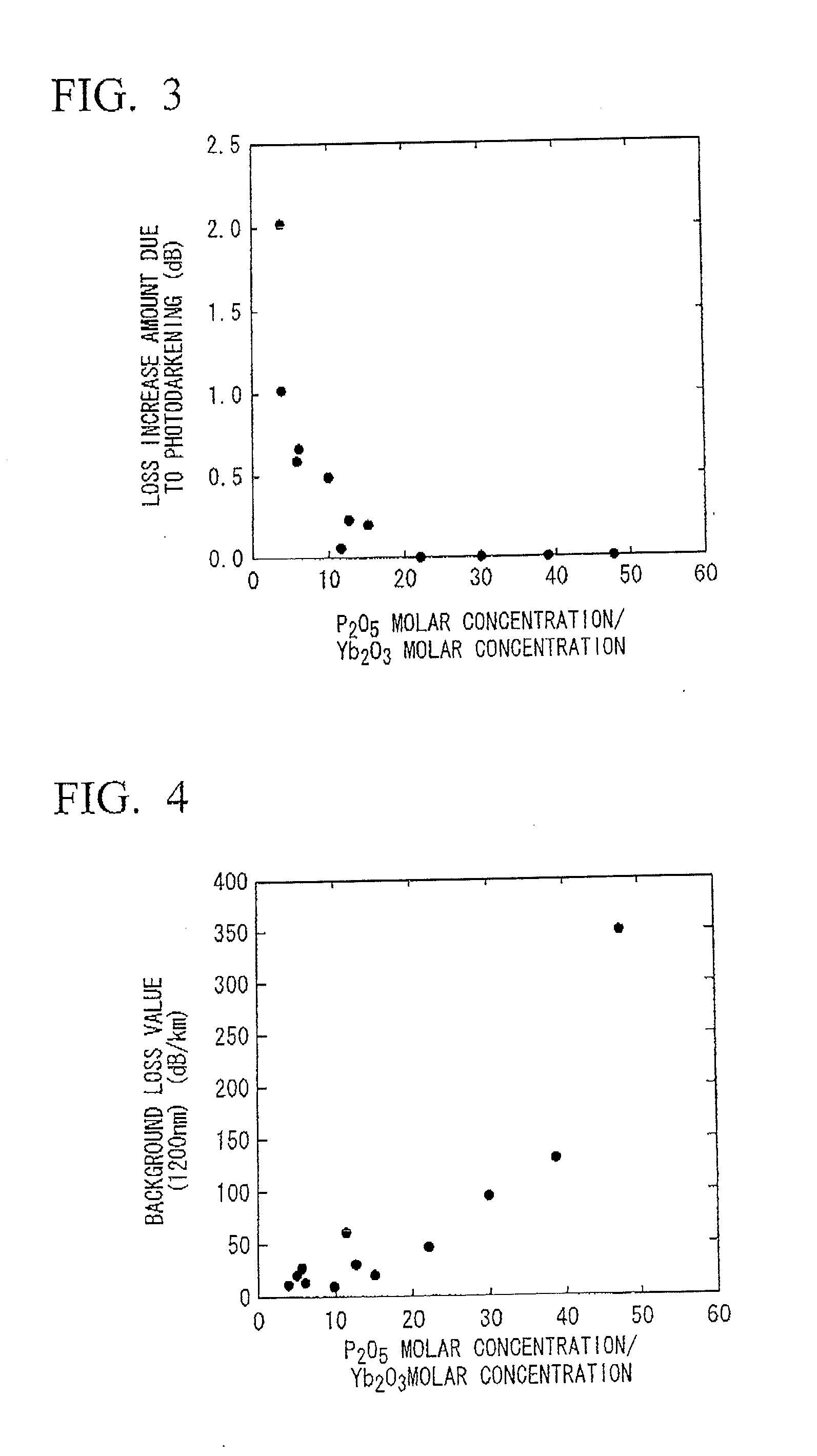Ytterbium-doped optical fiber
a technology of ytterbium-doped optical fibers and ytterbium-doped fibers, applied in the direction of cladded optical fibers, instruments, optical elements, etc., can solve the problems of deterioration, loss of optical fiber output, loss of optical fibers, etc., to suppress the increase of the refractive index of the core, inhibit non-linear optical effects, and inhibit photodarkening and background loss
- Summary
- Abstract
- Description
- Claims
- Application Information
AI Technical Summary
Benefits of technology
Problems solved by technology
Method used
Image
Examples
experimental example 1
[0092]Yb-doped optical fiber was prepared. The prepared Yb-doped optical fiber was a single clad fiber, which included a clad provided at the periphery of the core and a protective coating layer provided at the periphery of the clad.
[0093]The fiber preform was prepared by an MCVI) method, Further, ytterbium was added by a solution doping method. In addition, the protective coating layer was provided at the periphery of the clad by drawing the fiber preform until the outer diameter of the glass was adjusted to be about 125 μm.
[0094]In the case where the molar concentration of ytterbium oxide (Yb2O3) in the core was maintained at 0.20 mol %, the molar concentration of aluminum oxide (Al2O3) in the core was maintained at 2.5 mol % and the molar concentration of diphosphorus pentoxide (P2O5) in the core was varied, the variation in relative refractive index difference (Δ) between the core and the clad for the Yb-doped optical fiber was obtained.
[0095]The results are shown in FIG. 1.
[009...
experimental example 2
[0098]The variation (Δ) in relative refractive index difference between the core and the clad for the Yb-doped optical fiber was obtained, in the case where the molar concentration of diphosphorus pentoxide (P2O5) in the core was varied, in the same manner as in Experimental Example 1 except that the molar concentration of ytterbium oxide (Yb2O3) in the core was maintained at 0.10 mol % and the molar concentration of aluminum oxide (Al2O3) in the core was maintained at 2.5 mol %, and was then shown in the type of graph as FIG. 1 (not illustrated).
[0099]From these results, it can be seen that, in the case where the molar concentration of diphosphorus pentoxide was about 2.5 mol %, which is substantially equal to the molar concentration of aluminum oxide, the relative refractive index difference between the core and the clad was a minimum. Further, in a region with a concentration higher than the molar concentration of diphosphorus pentoxide at which the relative refractive index diff...
experimental example 3
[0102]The variation (Δ) in relative refractive index difference between the core and the clad for the Yb-doped optical fiber was obtained, in the case where the molar concentration of diphosphorus pentoxide (P2O5) in the core was varied, in the same manner as in Experimental Example 1 except that the molar concentration of ytterbium oxide (Yb2O3) in the core was maintained at 0.40 mol % and the molar concentration of aluminum oxide (Al2O3) in the core was maintained at 5.0 mol %, and was then shown in the type of graph as FIG. 1 (not illustrated).
[0103]From these results, it can be seen that, in the case where the molar concentration of diphosphorus pentoxide was about 5.0 mol %, which is substantially equal to the molar concentration of aluminum oxide, the relative refractive index difference between the core and the clad was a minimum. Further, in a region with a concentration higher than the molar concentration of diphosphorus pentoxide at which the relative refractive index diff...
PUM
| Property | Measurement | Unit |
|---|---|---|
| oscillation wavelength | aaaaa | aaaaa |
| refractive index | aaaaa | aaaaa |
| refractive index | aaaaa | aaaaa |
Abstract
Description
Claims
Application Information
 Login to View More
Login to View More - R&D
- Intellectual Property
- Life Sciences
- Materials
- Tech Scout
- Unparalleled Data Quality
- Higher Quality Content
- 60% Fewer Hallucinations
Browse by: Latest US Patents, China's latest patents, Technical Efficacy Thesaurus, Application Domain, Technology Topic, Popular Technical Reports.
© 2025 PatSnap. All rights reserved.Legal|Privacy policy|Modern Slavery Act Transparency Statement|Sitemap|About US| Contact US: help@patsnap.com



